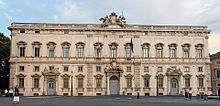Sacra Congregazione della Consulta
The Sacra Congregazione della Consulta (also Tribunale della Sacra Consulta called short Sacra Consulta ) was a congregation of the Curia of the Roman Catholic Church . The Sacra Consulta had initially judicial and advisory functions. It later became a court of appeal in criminal matters .
The Sacra Consulta was created in 1559 as a special commission. It was officially built on January 22, 1588 by Sixtus V. Since the 18th century it has been in the Palazzo della Consulta on the Quirinal in Rome . It was finally dissolved by Paul VI.
history
Pope Paul IV. Was formed in 1559 a commission of four cardinals who on the territory of the Papal States resolve grievances and should end disputes between his own nephew and the feudal lords. With the Apostolic Letter Immensa aeterni Dei of January 22, 1588, Sixtus V founded the Sacra Congregatio per consultationibus negociorum status ecclesiastici with the lowest rank among the fifteen newly established congregations. Their tasks included police functions as well as the health administration of the Papal States. It initially consisted of five cardinals, one of them as prefect , and a secretary who was also chairman of the Consulta court and vice- chairman of the health commission. The additional staff consisted of "components" (from latin ponere who hold ' ) officials referred to their tasks each, listed in a given territorial area ponenza who held. The Consulta exercised its sovereign powers over laypeople throughout the Papal States , with the exception of the legations and the exempten cities of Rome, Benevento , Spoleto , Fermo and Ceneda .
With the Apostolic Constitution Post diuturnas of September 30, 1800, Pope Pius VII confirmed the jurisdiction of the Consulta and added to it the competence as a court of appeal in criminal matters for appeals or revisions against judgments of the baronial courts. With the Motu proprio Dopo le orribili calamità of October 5, 1824, Leo XII. to the Consulta the function of a court of appeal for the entire Papal States, with the exception of the legations, for which a court of appeal in Bologna was responsible. With the Code of Criminal Procedure, which Gregory XVI. on November 5, 1831, it was transformed into the Supreme Court of the Papal States in criminal matters. The Tribunal of the Consulta was divided into two "courses" (Senates), one of which negotiated under the chairmanship of the Dean of the Ponenten and the other under that of the Secretary. In addition, it gained the character of a special court for political criminal matters. On the other hand, the Consulta lost under Gregory XVI. their responsibility for health administration, which passed on to the Congregazione speciale sanitaria (Health Congregation ) established on July 20, 1834 . However, the secretary and the ponents of the Consulta continued to play an important role in this congregation.
The Consulta special court was abolished by Article 4 of the liberal constitution of March 17, 1848, but was re-established in the course of the Restoration in the summer of 1849. During the last two decades of the Papal States , the consulta acquired a sinister reputation as the main instrument of oppression of papal rule among the liberals and the Italian patriots.
Its activity ended with the incorporation of the Papal State into the Kingdom of Italy on September 20, 1870. However, the Consulta was not formally dissolved until the 20th century by Paul VI.
literature
- Philippe Bountry: Congrégations cardinalices permanentes . In: Souverain et pontife. Recherches prosopographiques sur la Curie Romaine à l'âge de la Restoration (1814–1846) . École française de Rome, Rome 2002, II.17 - Consulte, margin no. 140–143 (French, online edition [accessed May 13, 2020]).
